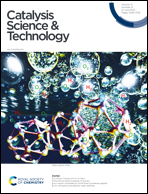Efficient electrochemical CO2 conversion by cobalt-based metal organic frameworks modified by bimetallic gold–silver nanostructures†
Abstract
The ongoing and rapid growth of atmospheric CO2 levels causes a crucial worldwide concern. Herein, an efficient electrocatalyst has been introduced for electrochemical CO2 reduction reaction (CO2RR) to address the stability issue of ZIF-67. The catalyst consists of gold and silver nanostructures electrodeposited on the surface of a cobalt-based metal–organic framework (Au–Ag@ZIF-67). The uniform distribution of the Au–Ag alloy without any agglomeration on ZIF-67 was confirmed through microscopic observations. After 13.3 h of CO2RR, the specific surface area of Au–Ag@ZIF-67 slightly decreased, whereas that of ZIF-67 declined drastically, indicating excellent structural stability of the Au–Ag alloy. Additionally, Au–Ag@ZIF-67/GCE revealed a faradaic efficiency of 53% and 38% for CO and H2, respectively. The enhanced CO2 absorption coupled with the effect of noble metal catalysts offered a current density of 16.4 mA cm−2 at −1 V (vs. RHE) with 91% Faradaic efficiency. The results indicate that ZIF-67 enhanced the adsorption capacity of CO2 molecules in comparison with the bare GCE. The combination of ZIF-67 with bimetallic Au–Ag nanostructures offers enhanced CO2 absorption and reduced charge transfer resistance, leading to improved catalytic activity and selectivity toward CO gas. The results suggest that the use of Au–Ag nanostructures provides superior catalytic activity compared to traditional catalysts, making this approach a promising development for CO2 gas elimination in the environment.



 Please wait while we load your content...
Please wait while we load your content...